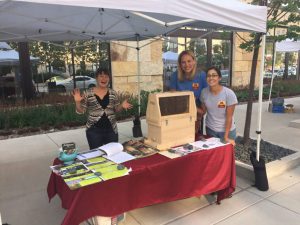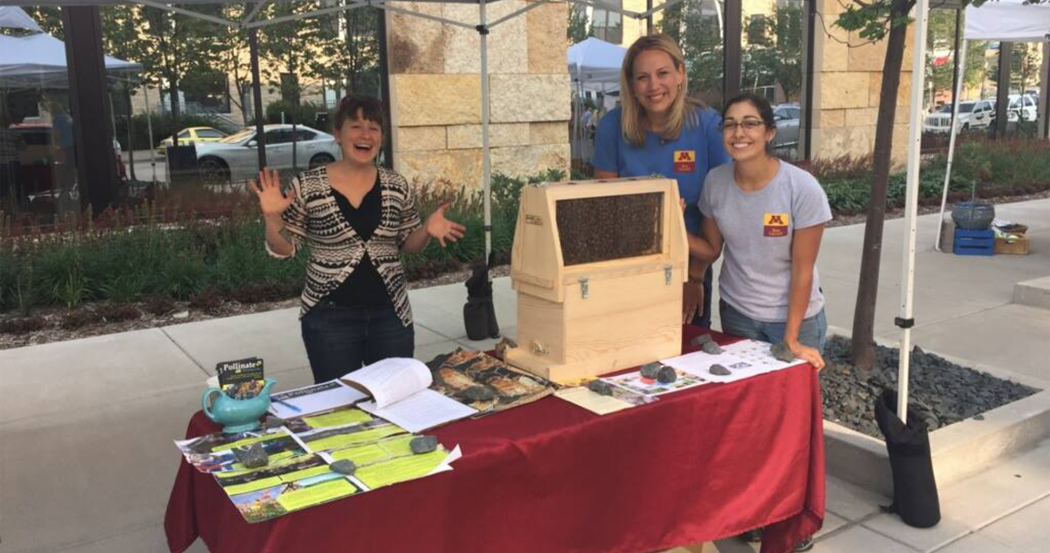Minding Your Bees and Cues
By: Becky Masterman & Bridget Mendel

Figure 1. Erin Rupp of Pollinate Minnesota, Anne Turnham (center) and Ana Heck, formerly of University of Minnesota Bee Squad, now Michigan State University Extension educator for Apiculture ready for a day of honey bee outreach.
This year we decided to interview beekeeper Anne Turnham. Even though she doesn’t like to talk about herself and would have rather been on a walk with her best friend and golden retriever Birdie, we figured we’d get her out of her comfort zone because we think that you all will find her story interesting. It’s hard to make a living with bees, but Anne has found really creative ways to center her love for bees in her life and career. Besides keeping her own colonies, she started and runs her own honey label business and works for the UMN Bee Lab’s Bee Squad doing graphics, visual outreach and educational videos.
Q: What first got you hooked on honey bees?
A(nswer/nne): It was when CCD was making the news. I wanted to find out more and just understand what was going on. I took a class, which was mostly inside, but we did get to go outside into an apiary and stand next to the bees. I found it so fascinating that I decided to become a beekeeper by the end of the weekend.
Q: Were you afraid of bees at all when you first started?
A: No. I’d worked with cockroaches in a past job, so bees were less scary. I have a background in Biology and Chemistry and have always loved nature and understanding nature. So, once I decided to get into beekeeping, I devoured every book and class about bees that I could get my hands on. If I was going to do it, I wanted to do right by my bees. Then, in return, my honey bees became this way for me to connect with nature while being at home with my three kids.
Q: What have you learned from the bees over your years of beekeeping?
A: How connected we are to the health of habitat. Bees are such a direct window into what is happening in the environment. They tell you if the environment is healthy. With hive loss, I could directly trace that onto the landscape. Through bees, I learned how closely we are connected to habitat, and how important it is to plant for bees.
Q: Okay so you run your own honey label business and you do the graphics for all the Bee Lab’s educational materials. How did you go from biology to design?
A: I’m self-taught. Learning graphic design was a means to do what I wanted to do. And what I wanted to do was to help bees and beekeepers. After I fell in love with bees, I fell in love with the beekeeper community. They care about insects, these tiny little insects, which just is a testament to how much they care about the world and all living things.
Q: Tell us a bit more about your honey label business*.
A: I started making honey labels for my own honey that I produced along with two of my friends with whom I shared an apiary. I learned Photoshop. Then I put a little blog out with some designs for my friends, but I did not anticipate that it would turn into a business. But there was a need, and people found out. Honey producers are really proud of their honey and they were looking for labels that reflected their pride and their unique businesses. My first order was actually from California. Someone put my designs on a bigger blog, and then suddenly I was getting a ton of customers!
Q: You work for the UMN Bee Lab doing visual education and science communication. What’s your philosophy or goal with this type of work?
A: I tried to volunteer for the squad because I thought they were the coolest. But instead they hired me as a beekeeper. As time went on I started doing more and more graphics work for the team. My first project was designing the labels and instructions for our Varroa Mite Testing Kit.
As to what my goal is, my goal is to help scientists and pollinator educators put content out in the world that will help bees and in turn help the health of the planet.
Q: You have a special talent for turning complex information into very accessible visual descriptions. What happens in your head when you start thinking about how to communicate a given topic visually?
A: I listen a lot and let things percolate before jumping in. My husband David calls it “cluing it.” I always win at the game Clue because I take copious notes and never miss a detail. It’s not that I’m competitive. It’s more like I want to fix a puzzle. I use my “cluing it” energy to puzzle out how to visualize a concept. I ask a million questions because I want to hear the way [other people] understand things. Another important part of my process is going for long walks. My mind needs to wander.
Q: What are infographics and why are they an important communication tool?
A: Infographics are basically simple illustrations, typically one or two colors paired with text to give you a snapshot of what a longer text is about. They support neurodiverse learners because they cue into what the content is going to be about, giving you a way to digest information or even decide if you want to dig in further. It’s a different way of skimming information you want to learn.
Q: Do you think of yourself as an artist?
A: More like a translator.
Q: Thanks Anne! We’re going to go ahead and call you an artist anyway! We appreciate your sharing the ways in which you support honey bees and the ways in which they support you back!
For more information:
https://beelab.umn.edu/manuals
https://anneturnham.myportfolio.com/work
*A note from the authors: Anne is currently not taking new honey label customers in order to meet the needs of her current clients!
(Below) Figure 2. A graphic imagined and designed by Anne Turnham for the University of Minnesota Beekeeping in Northern Climates manual.










